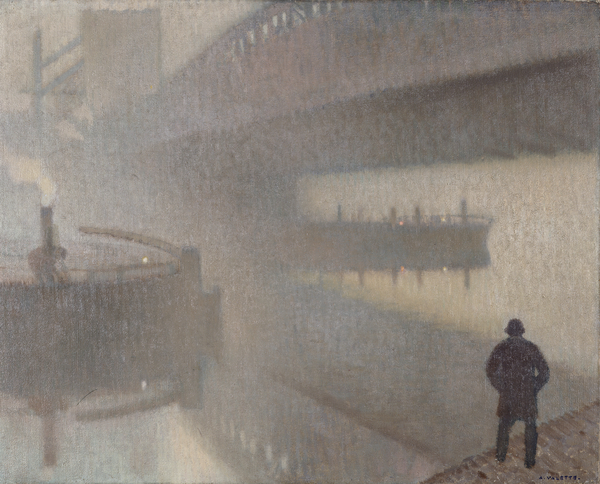Under Windsor Bridge on the Irwell, Manchester
Summary
A smog-filled, hazy view of the River Irwell, seen from the riverbank with the Irwell Street Bridge (incorrectly identified as Windsor Bridge) overhead. In the foreground to the right, on the edge of the bank is a dark, solitary figure wearing a brimmed hat and knee-length coat. He is stood with his hands in his pockets looking out across the still water. On the left, a barge with a smoking funnel noses into the scene, about to pass under the Irwell Street Bridge on the right. The bridge is characteristic of the industrial era with open ironwork construction and arched sides. On the far side of the bridge is a second, similar barge; it’s lights visible through the haze. The vessels are a known as a 'Mersey Flat', a wide variety of barge used for transporting goods.
Display Label
Channel Crossings English and French Impressionism and Post-Impressionism from the collection of Manchester Art Gallery This display looks at the allure and excitement of French art for a generation of English and Scottish painters emerging from the claustrophobia of late Victorian painting. Breaking with the Classical rigours of the Academy and the Salon, the artists who came to be known as the Impressionists painted naturalistic scenes with loose and quickly applied brushwork to convey the effects of light and the natural colours of shadows which had previously been rendered with blacks and browns. They explored the French countryside where they learned how to paint directly en plein air closely studying the changing effects of the seasons. Making regular visits to or studying in Paris, English and Scottish artists were in turn enthralled by these painterly discoveries. The new method of painting they then applied to the English landscape, to still lifes, portraits and interiors. Painters of the New English Art Club like George Clausen, John Singer Sargent and Philip Wilson Steer combined the subject matter of late Victorian genre scenes with the new style. Works by these artists and others are here shown alongside a few choice examples of French Impressionism from the collection and by the fore-runners of Impressionism; Eugène-Louis Boudin, Charles Daubigny and Johan Jongkind. While the English artists went to France the French painters and their dealers, such as Paul Durand-Ruel, escaped the Franco-Prussian war of 1870-71 and went to London. Their paintings were seen in England and some were even bought by Manchester collectors. In the Edwardian era newer developments in French art inspired English and Scottish artists on their cross-Channel trips and via a series of influential London exhibitions. The high-keyed colour and bold lines of the Post-Impressionist paintings of Paul Gauguin and Vincent Van Gogh were now huge influences on the artists of the Camden Town Group such as Harold Gilman and Charles Ginner. Later still Matthew Smith was to take his inspiration directly from Henri Matisse under whom he studied in Paris.
Object Name
Under Windsor Bridge on the Irwell, Manchester
Creators Name
Date Created
1912
Dimensions
Canvas: 48.2cm x 61cm
Frame:
accession number
1928.32
Place of creation
Manchester
Support
Linen on Jute
Medium
Oil on linen on jute
On Display
[G16] Manchester Art Gallery - Gallery 16
View all
Credit
Purchased from the Artist
Legal
© Manchester Art Gallery

